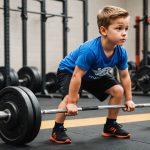Essential Safety Guidelines for Kids Beginning Weightlifting: A Comprehensive Guide
Understanding the Benefits and Risks of Weightlifting for Children
Before diving into the safety guidelines, it’s crucial to understand why weightlifting can be beneficial for children and adolescents. Weightlifting, when done correctly, can enhance strength, improve athletic performance, and reduce the risk of injuries in sports. A study on the benefits and risks of strength training for children and adolescents highlights that properly structured programs can lead to significant improvements in muscular strength and overall physical fitness.
However, it’s also important to acknowledge the potential risks, such as damage to growth plates in younger children. Dr. Thomas Solecki, a sports medicine expert, advises that children under the age of 12 should avoid using weights or heavy lifting to prevent damage to their growth plates.
Also read : Top Agility Drills to Elevate Your Basketball Skills: Unlock Your Full Potential!
Assessing Readiness and Age Considerations
Determining the Right Age to Start
The age at which a child can safely begin weightlifting is a critical consideration. Generally, children should be at least 7 to 8 years old before starting any form of resistance training, but this can vary depending on their physical and emotional maturity. For younger children, bodyweight exercises are often recommended until their growth plates have closed.
Evaluating Physical and Emotional Maturity
It’s not just about the age; it’s also about the child’s physical and emotional readiness. Children should demonstrate a basic understanding of proper form and technique, as well as the discipline to follow safety guidelines. Here are some key factors to consider:
Also to see : Top Recovery Techniques to Combat Muscle Fatigue in Ultracycling
- Physical Maturity: The child should have sufficient strength and coordination to perform exercises safely.
- Emotional Maturity: The child should be able to follow instructions, understand the importance of safety, and manage their own fatigue and pain levels.
- Interest and Motivation: The child should show a genuine interest in weightlifting and be motivated to learn and improve.
Creating a Safe Training Environment
Equipment and Facilities
Ensuring the training environment is safe is paramount. Here are some guidelines for setting up a safe weightlifting area:
- Equipment Inspection: All equipment must be checked before use and repaired as necessary. Ensure that free-weight plates are secured in place before using.
- Proper Flooring: The floor surface should not allow weights to slide or slip. A utility mat should be placed directly below high apparatus like chinning boards or peg boards.
- Adequate Space: Allow adequate space between weight-training activities to provide free flow of motion and prevent accidents.
Supervision and Instruction
Proper supervision and instruction are crucial for safe weightlifting. Here are some key points:
- On-Site Supervision: Ensure that there is on-site supervision during the use of free weights and weight machines. This can be a qualified coach, trainer, or physical education teacher.
- Instruction on Proper Techniques: All students must be instructed in the proper lifting techniques and safety procedures. Skills and procedures should be reviewed regularly to ensure compliance.
Developing a Safe Training Program
Assessment of Needs
Before designing a training program, it’s essential to assess the child’s needs and goals. Here are some steps to follow:
- Identify Performance Goals: Understand what the child aims to achieve through weightlifting, whether it’s to improve overall strength, enhance sports performance, or simply to stay fit.
- Analyze Physical Demands: Analyze the primary movements, muscles involved, and typical patterns of play in their sport or activity. This helps in designing a program that aligns with their specific needs.
Designing the Training Program
A well-structured training program should include the following elements:
- Sport-Specific Training: For young athletes involved in sports, the training program should be sport-specific. For example, football players might include drills that improve explosive power and agility, while tennis players could focus on lateral movements and rotational exercises.
- Progressive Overload: Gradually increase the intensity of workouts by no more than 10% every two weeks to avoid overtraining and injury.
- Variety of Exercises: Include a variety of exercises that closely simulate actual sports actions. This enhances both relevancy and effectiveness of the training program.
Monitoring Progress and Adjustments
Regular monitoring of the child’s progress is essential. Here are some ways to do it:
- Formal Evaluations: Use timed drills or strength assessments to evaluate progress.
- Informal Feedback: Collect feedback from the child on their performance and fatigue levels.
- Adjustments: Make adjustments to the training program based on the assessments. This could involve increasing the intensity of workouts, introducing new exercises, or scaling back if there are signs of overtraining or injury risk.
Safety Tips and Precautions
Warm-Up and Cool-Down
Proper warm-up and cool-down routines are vital for preventing injuries.
- Warm-Up: Warm up with light to moderate activity for at least 5-10 minutes before exercising. This should include dynamic stretches to prepare the muscles for the upcoming activity.
- Cool-Down: Cool down and stretch after every workout. Hold each stretch for 30 seconds to one minute without bouncing.
Hydration and Nutrition
Proper hydration and nutrition are essential for safe and effective weightlifting.
- Hydration: Drink at least 64 oz (eight 8 oz glasses) of water per day. During intense and prolonged exercise sessions, drink 8-10 oz every 20 minutes.
- Nutrition: Ensure the child has a balanced diet that includes adequate protein, carbohydrates, and healthy fats to support muscle growth and recovery.
Recognizing Pain and Injury
It’s important to differentiate between normal muscle soreness and injury.
- Normal Soreness: Some muscle soreness is normal, especially after starting a new exercise program. This is indicative of lactic acid build-up and is necessary for building stronger muscles.
- Injury Warning: If the child experiences significant pain or delayed onset muscle soreness (DOMS), it may indicate overtraining or injury. In such cases, it’s crucial to back off and consult with a healthcare professional.
Special Considerations for Children with Medical Conditions
Weightlifting with Scoliosis
For children with scoliosis, weightlifting can be beneficial but requires special precautions.
- Consultation: Consult with a healthcare professional or a certified trainer who understands the condition. Proper form and posture are essential to mitigate the effects of scoliosis on physical activities.
- Safe Exercises: Avoid exercises that put additional stress on the lower back, such as squats and deadlifts. Use techniques like the Schroth method to safeguard activities and ensure muscle symmetry.
Practical Tips for Parents and Coaches
Here are some actionable tips for parents and coaches to ensure safe and effective weightlifting for kids:
Start with Bodyweight Exercises
For younger children, start with bodyweight exercises until they are physically and emotionally ready for weightlifting.
Use Proper Equipment
Ensure that all equipment is checked before use and that children are instructed on how to use it safely.
Focus on Technique
Emphasize proper form and technique over the amount of weight lifted. This helps in preventing injuries and ensuring long-term benefits.
Encourage Recovery
Include adequate rest days and recovery techniques such as stretching, massage, or foam rolling to help the body heal and repair.
Weightlifting can be a highly beneficial activity for children when done safely and correctly. By following these comprehensive safety guidelines, parents, coaches, and young athletes can ensure a positive and injury-free experience.
Summary of Key Points
Here is a detailed bullet point list summarizing the key points:
- Assess Readiness: Ensure the child is physically and emotionally ready to start weightlifting.
- Safe Environment: Set up a safe training environment with proper equipment and supervision.
- Structured Program: Develop a structured training program that is sport-specific and progressive.
- Monitoring Progress: Regularly monitor progress and make necessary adjustments.
- Safety Tips: Follow safety tips including proper warm-up and cool-down routines, hydration, and recognizing pain and injury.
- Special Considerations: Take special precautions for children with medical conditions like scoliosis.
Table: Comparison of Safety Guidelines
| Aspect | Guideline | Source |
|---|---|---|
| Age Consideration | Children should be at least 7-8 years old before starting weightlifting. | |
| Equipment Inspection | All equipment must be checked before use and repaired as necessary. | |
| Supervision | On-site supervision is required during the use of free weights and weight machines. | |
| Progressive Overload | Gradually increase the intensity of workouts by no more than 10% every two weeks. | |
| Warm-Up and Cool-Down | Warm up with light to moderate activity for at least 5-10 minutes and cool down with stretching after every workout. | |
| Hydration | Drink at least 64 oz of water per day and 8-10 oz every 20 minutes during intense exercise. | |
| Special Considerations for Scoliosis | Consult with a healthcare professional and avoid exercises that stress the lower back. |
By adhering to these guidelines and tips, young athletes can safely and effectively engage in weightlifting, enhancing their strength, performance, and overall well-being.











